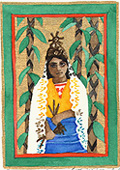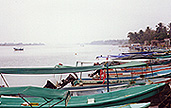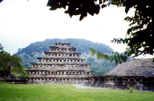The small fishing town of Tecolutla straddles the Gulf of Mexico and the Rio Tecolutla in the northern part of Veracruz State. Apart from school vacations and the annual fishing tournament nothing much happens around here – which is why we like it. One has the feeling of being lost in another time and place – perhaps in Key Largo with Bogie and Bacall circa 1949.

Hotel Tecolutla was in fact built in 1949 and it feel like nothing much has changed here since then. Towns on the Gulf Coast lack the pizzazz of Mexican resorts such as Cancun in the Caribbean, or Ixtapa or Acapulco on the Pacific. Fickle weather means it cannot guarantee the requisite number of hot and sunny days investors demand. This is why beaches on the Gulf Coast never quite make it as big resorts.
But that is part of its charm. Hotel Tecolutla overlooks the Gulf of Mexico. One can sit on the terrace, looking out to sea and watch a storm blow up, a cold beer or margarita in hand. Well, maybe Bogie and Bacall didn’t drink margaritas but there sure was a storm blowing once when we were there – just like in Key Largo. Called Nortes, these cold fronts blast their way down the Atlantic coast to the Gulf, and they can hit during December to February. In the morning, we were sunning ourselves on the beach and by evening we were rummaging in our luggage for some warmer clothes.

There is something romantic about being holed up in a hotel like this with faded grandeur, facing the beach, the palms swaying and no one much about. I love the beach when the sea reminds us of its omnipotence. For years the Hotel Tecolutla was just about the only building in town. However, nowadays the town is enjoying a small boom, with budget hotels built to capture vacationers, especially from Mexico City, or perhaps Xalapa, the state capital.
Fishing is the draw card internationally and there is a big game fishing tournament every February for tarpon. But outside the peak vacation period or the tournament there are very few visitors. On our last trip, my husband went out fishing with Alejandro who organizes trips on the river in his boat. He returned triumphant with 2 hurel and 2 sabre fish. Alejandro seemed as intent on catching a fish as my husband. He’s the type of guide who gets as much pleasure as you in your catch.
His fishing boat is docked right in front of one of our favorite places in town: El Caracol restaurant, run by Maria de Lourdes Morena Rodrigues.
In late 1999 tremendous floods swept through the area and Maria de Lourdes’ kitchen and restaurant washed into the river. At present she is working from a small makeshift kitchen. Her simple restaurant has a dirt floor, but the tables are covered in fresh cloths every day and the wooden chairs give the place a cheery air.

Lourdes prepared the fish for us that night, baked in foil with vinegar, and we talked for hours about our mutual passion: food. We returned for breakfast the next morning as promised, to find that she had decided to give me an impromptu cooking lesson. We made bocoles (little cakes of corn masa with enough lard to make them sinfully moreish), more of her baked fish, and shrimp stuffed with zaragalla a local specialty of shredded fish cooked with herbs, spices, tomato and chile. This was all served with Veracruz style black beans and wonderful coffee.
Lourdes works with the most basic of tools, and deftly bones a fish with a small serrated knife. She gently washed the fish in the garlicky vinegar mixture as if bathing a baby: patting and rubbing as she went. She was a wonderful teacher and a naturally talented cook. The restaurant is apparently called “El Caracol,” but I never saw a sign. You can’t miss it though; just take the street through town to Ribera del Rio or the dock on the river. On the left is Lourdes’ restaurant. You can’t miss her either – smiling, friendly and a smart businesswoman.
After a day or two of hanging around doing nothing much it’s time to do a bit of sightseeing. The surrounding countryside is picturesque with rolling hills, light jungle and citrus groves.
Note: When I returned to Tecolutla in March 2001, Lourdes had made more renovations and additions to her restaurant. A new sign, for one – but also a trellis around the restaurant, a new kitchen and she is planning a new floor. Get there before she franchises!! She is still her amiable, wonderful self.

The nearest city to Tecolutla, Poza Rica, means “rich well” and this is the center of Mexico’s oil industry. The increasing number of cattle farms has led to deforestation, which probably contributed to the degree of devastation caused by the floods in late 1999. Most of this damage has now been repaired and many reconstructed roads and bridges are better than before.
Just 30 minutes away from Tecolutla is the archaeological site of El Tajin set in a narrow valley in the jungle. This is the site of an ancient city, which was at its peak in the early Post-Classic period, from around 600 A.D. and was abandoned around 1200. The unique style of architecture features rows of niches on the buildings – the Pyramid of the Niches is the finest example of this.
The site has an extraordinary number of ball courts for the game that was played across Meso-America in pre-Hispanic times. The famous bas-reliefs on the walls of the southern court give us insights into the rituals surrounding the game at that time. The Voladores (flying men) perform their ancient ritual ceremony everyday outside the museum attached to the site.

When Cortes landed on the shores of Mexico (at Zempoala), the first people he encountered were the Totonac Indians. Today, descendents of these people can be spotted throughout the region by their distinctive dress. The men wear white, wide-leg trousers, gathered to a tight cuff above the ankle. Shoes, if worn, are usually black cowboy style boots. The loose white shirt, gathered from a yoke, sometimes has a small cape at the back.
The women also wear white — an embroidered blouse and lacy skirt. Over this they wear a brightly coloured half-apron and an equally bright scarf which is a variation on the ancient quechquémitl. It is tied at the back of the neck, draped across the bosom then tucked into the apron. For festive occasions the women may wear a lace mantilla.

This is vanilla country. Along with chocolate, vanilla is arguably Mexico’s best-loved gift to the world and it originated right around here! The Totonac Indians have been specialists in growing vanilla since pre-Hispanic times and the Aztecs demanded vanilla be sent as tribute to the Emperor. Today the towns of Papantla and Zamora are the centers of the Mexican vanilla industry and at harvest time (November/December) one can see the precious beans being cured in the sun. Buy some vanilla beans in the Papantla market or some extract, but only from a reputable distiller such as Gaya Vai-Mex in Zamora.
If like us, you don’t enjoy the hoopla of major resorts; if you long to re-live life from another era, when travel was not so hectic; if you want to spend some time at the end of the road, in far away places with strange sounding names like Casablanca, Key Largo or… Tecolutla, then head to northern Veracruz and kick back — like Bogie and Bacall.
HOW TO GET THERE

Tecolutla is about a 5-hour drive from Mexico City through spectacular scenery. Crossing the high and often misty mountains of the Sierra Madre Oriental, you eventually descend through orange and banana groves to the ” tierra caliente” of the Gulf Coast. The road in from Zamora leads directly to the hotel entrance From Tecolutla, you can continue along the Costa Esmarelda to the port City of Veracruz.
Note: A new toll road, which will connect to the D. F. and leads on to Tuxpan, seems to be nearly ready to open. It will cut the time from D. . considerably.
Rhonda Tranks of Las Campanas conducts a 12-day tour, which includes this region – A Taste of Veracruz and Puebla. Contact her for more information [email protected]
Tel: +52 (73)172 678

